This was published 6 months ago
The name of this vibrant, foodie paradise was drawn out of a hat
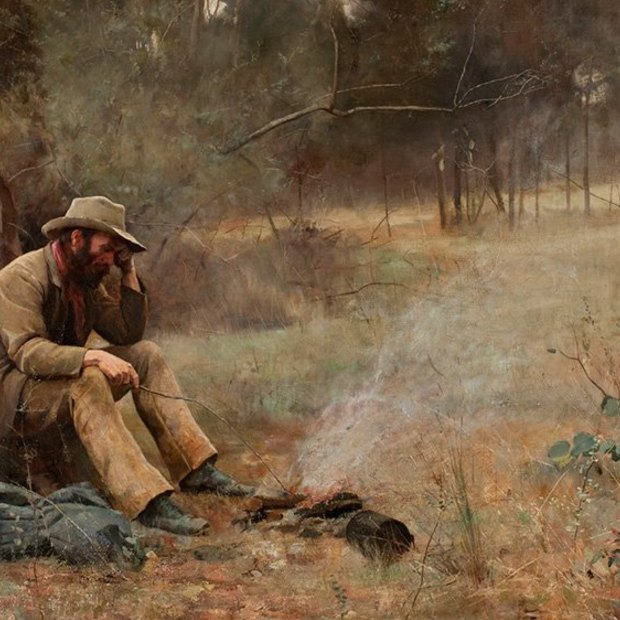
Modern Box Hill looks vastly different to how McCubbin painted it in 1889.Credit: Frederick McCubbin
In Frederick McCubbin’s Down on His Luck, a melancholy gold prospector pokes at the coals of a campfire, surrounded by the thick bush of late 19th century Victoria.
While the artist’s 1889 oil-on-canvas shows a scene reminiscent of the Grampians or Wilson’s Promontory, it was actually painted in Box Hill.
More than a century later, the towering gums and dense bush have been replaced by looming skyscrapers and high-density living. This eastern Melbourne suburb has developed into one of Victoria’s “second cities”, known for its large Chinese population. In Box Hill, 46.6 per cent of the population has Chinese heritage. The state average is 6.6 per cent.
Refugee turned restaurateur Nicholas Wynn has Chinese ancestry, but was born in Kampot, Cambodia.
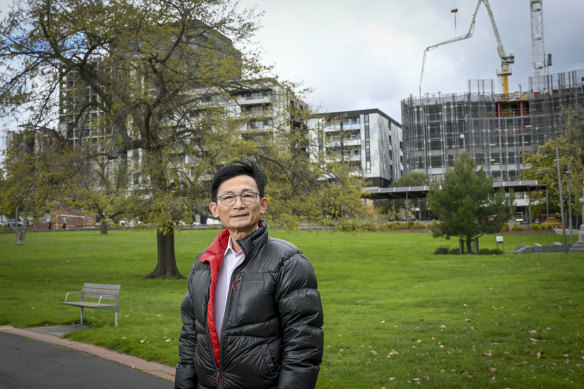
Nicholas Wynn sponsored the visas of 22 of his family members to Australia. Credit: Eddie Jim
As a child, he fled the Khmer Rouge, first to Vietnam and then Thailand, where he spent three months alone in a refugee camp. The boat trip from Vietnam to Thailand was supposed to take three days, but a storm and wrong turns made it a week-long journey.
Deciding on a country to become his new home, Wynn made the decision on scanty, sketchy information.
“I thought Australia never had a war before ... and that’s the reason I chose Australia,” Wynn told The Age over Chinese tea and Coca-Cola at his restaurant, Eastern Bell, in neighbouring Balwyn.
Wynn arrived in Melbourne in 1977, and has sponsored visas for 22 members of his family to come to Australia. In his late teens, he was looking after six children of family members.
He was determined to set a good example as the children’s primary carer. In the 15 years it took for him to bring his family to Australia, he only once spent a night away from home, going to a nightclub with a co-worker and pulling an all-nighter before heading into work the next morning.
Wynn bounced around Melbourne’s eastern suburbs before settling in Box Hill in 1996. “I love it,” he says, “I’ve seen it change so much.”
Shanghai-born tai chi master Wendy Jiang Hui has lived in Box Hill for about 20 years. She teaches the martial art to help others maintain their wellbeing, after she had her own health scare in hospital more than a decade ago.
This week she hosted a mid-autumn gala, with dozens of white-and-red clad tai chi students performing at the Box Hill Town Hall.
“I think Box Hill is more and more comfortable for the Asian people,” she said. “There’s a train, a bus, a tram, everything.”
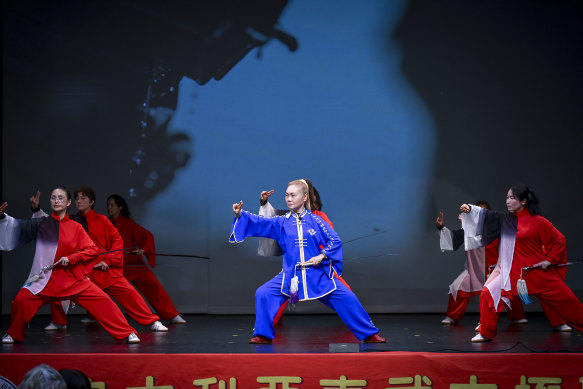
Tai Chi Master Wendy Hui Jiang (centre) performs at Box Hill Town Hall on Thursday. Credit: Eddie Jim
Tina Liu, a former mayor of Whitehorse and business owner, remembers migrating to the suburb as a child, with her family from Taiwan – and being the only Asian family in the neighbourhood.
“People were just so welcoming,” says Liu, who still lives in Box Hill. “It’s such a wonderful community.”
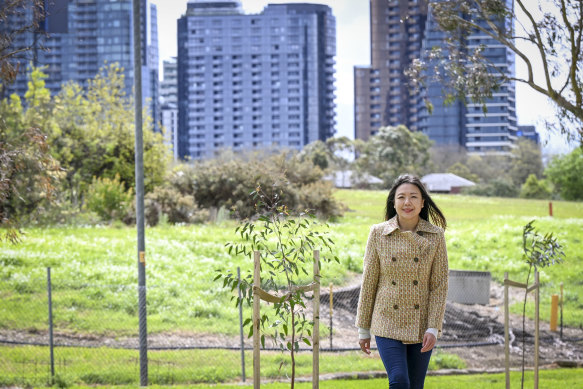
Tina Liu is a former Whitehorse Mayor and Box Hill business owner and resident. Credit: Eddie Jim
“It’s such a vibrant place, and it’s really a melting pot of different cultures as well. It’s very convenient.
“It is well regarded as a foodies’ paradise, particularly around some of that Asian cuisine.”
Box Hill Labor MP Paul Hamer says the area is unique.
“I love the diversity … of people, diversity of culture, diversity of things to do,” he says.
“People want to have good access to health, education, transport and Box Hill has all of those things.”
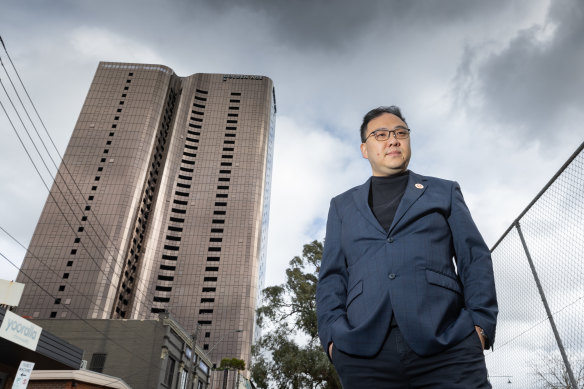
Richard Shi, standing in front of the 36-storey Sky one apartment tower, says Box Hill is comfortable and convenient for Chinese migrants. Credit: Jason South
Richard Shi, vice-president of the Asian Business Association of Whitehorse, says Chinese migrants are attracted to Box Hill for its convenience and comfort.
“You can speak only Chinese, and get by very well. So all of the services: banks, professional services, like lawyers, accountants, they all speak Chinese,” Shi said.
Convenience is why Shi’s parents moved from China when he was 7, settling in a Box Hill that was “very different”.
“Back then, it was just a little Chinese takeaway, a couple of Chinese butchers. But now a lot of the businesses, you can tell that their offering is targeted towards the Chinese people or the students.”
The Box Hill Historical Society reports the first Chinese business to open in Box Hill was a laundry on Station Street in 1923. The first Chinese restaurant was established in 1957.
The suburb’s name was likely drawn out of a hat, says the society’s secretary, Helen Harris.
“Box Hill was going to get a post office [and] the post department needed a name,” says Harris. “People put in suggestions, and the name was drawn out of a hat ... but as to who actually put that suggestion is doubtful at the moment.”
Harris says the local council’s decision in the 1950s to subdivide the orchards and promote Box Hill as a centre for development was key in shaping it into the modern city-scape it has become.
The repercussions of that are being felt today, with some residents concerned development will erode its character and green spaces.
Box Hill now stands out in Melbourne suburbia for its architecture. Heralded as a second city, skyscrapers sprout throughout its CBD.
Dr Mengbi Li, a senior lecturer in Built Environment at Victoria University, says there are many factors at play.
Chinese migrants settling in Box Hill, coming from cities like Shanghai, Beijing and Guangdong where apartment living is the norm, aren’t the dominant factor behind the suburb’s high-rises, Li said.
“The high Chinese population, it would be a factor for the high-rise apartments [but] it is not the sole reason,” says Li.
Box Hill’s proximity to Melbourne CBD, health and education facilities, transport infrastructure and investment opportunities have had a larger influence.
Li believes Box Hill now has the opportunity to diversify its architecture, away from high-rises.
“There’s so much more that could be offered beyond the density in practice,” she says.
Still, Box Hill is set to continue to grow upward.
When the train line first reached Box Hill in the 1880s, it gave McCubbin and his artistic colleagues easy access to the wilderness that inspired their Australian Impressionist paintings.
Now a new rail line – the Victorian government’s $34.5 billion Suburban Rail Loop mega project – is set to change the face of Box Hill again, with a train connecting Box Hill and Cheltenham stations (eventually circling the city all the way around to the west).
As part of the plan, the state government has set housing targets for each local government area. Whitehorse – which includes Box Hill, Mitcham, Blackburn, Vermont and Surrey Hills – has been told it needs to double its number of residences by 2051 – an additional 79,000.
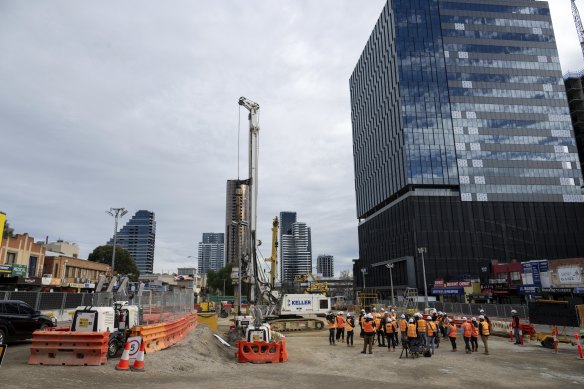
The Suburban Rail Loop has been one of Victoria’s most controversial infrastructure projects.Credit: Penny Stephens
A 50-storey tower has already been green lit for the suburb’s CBD, topping the 36-storey Sky One apartments – already the tallest tower in suburban Melbourne.
Some residents fear health and education facilities will struggle to keep up with the increased demand, and that the character of the area will be changed.
Box Hill North resident Heidi Krejcar says she isn’t anti-development.
“I’ve lived in Box Hill for 47 years, if I was against development, this is the last place that I would be,” she says.
Krejcar says is happy for the local population to grow – “provided the infrastructure is there”.
“And by infrastructure, I don’t mean a train that whizzes up and down from Cheltenham to Box Hill. I’m talking about schools, childcare, kindergartens, the pressures on the hospitals and the ambulance systems, the roads.
“The pressure on the roads, the lack of investment in schools, the drastic removal of open space and just bringing all these people in – it just screams to me a lot of poor planning.”
Krejcar also laments that infrastructure development has robbed the area of green spaces, including from the popular Box Hill Gardens.
But Hamer says feedback for the SRL has been very supportive.
“Back in May and June, there were a lot of information sessions … the conversations that I had were very positive,” he says.
“People want to see transport infrastructure in their area. They know it’s a congested area, and they see the solution to that is actually providing better transport.”
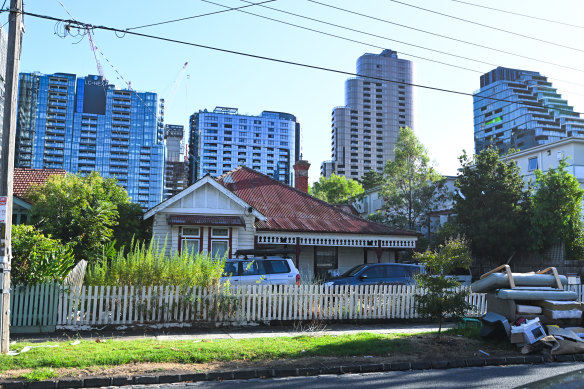
An old Box Hill weatherboard home is surrounded by high-rises.Credit: Joe Armao
Shi says Asian businesses hope that now construction has begun, the project is seen through.
“From the mindset of the Chinese community, I think … we’re so used to development.
“Everyone just doesn’t want to see it stop because the hole’s dug, don’t stop it, like at least finish a portion, don’t waste the money.”
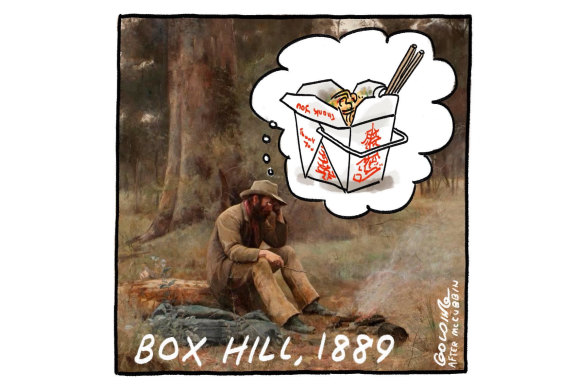
Credit: Matt Golding
Back at Eastern Bell, Wynn shares his own view on the changes to Box Hill, while a waitress brings out honey-pepper steak and prawn fried rice.
“We’ve become more dense,” he says. “My neighbour sold her house, now there’s four townhouses, and opposite there’s [another] two.
“I don’t mind because I was born in Cambodia and lived in Vietnam, Thailand. I was also a missionary in China, I got used to being surrounded by people.”
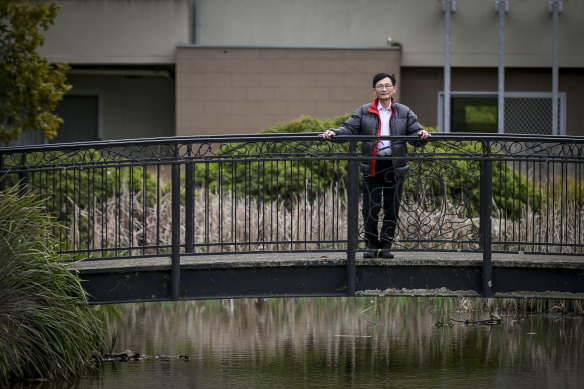
Nicholas Wynn’s time living in Cambodia, Vietnam, Thailand and China means he isn’t bothered by high-density living. Credit: Eddie Jim
However, Wynn says with a laugh, “as the strip becomes busier, you can’t put out your rubbish bin because someone’s car’s parked in the way.”
For school-leavers who opt not to go university, Box Hill Institute has provided vocational training for 100 years.
Its CEO Grant Radford says it has a deep connection to the area, and courses designed to “make sure we’re meeting the needs of the local communities”.
Joan Sweet was an early graduate, when there was a Box Hill Technical School for Girls and another for boys. She graduated in 1953 and returned as a home economics teacher in 1958.
As a student, Sweet travelled from her family’s peach orchard in Wonga Park to study in Box Hill.
In a brick coloured report book, Sweet’s work was evaluated by the principal. For six months of work she received four words: “Has done good work.” Summing up her year: “Completed a good year’s work.”
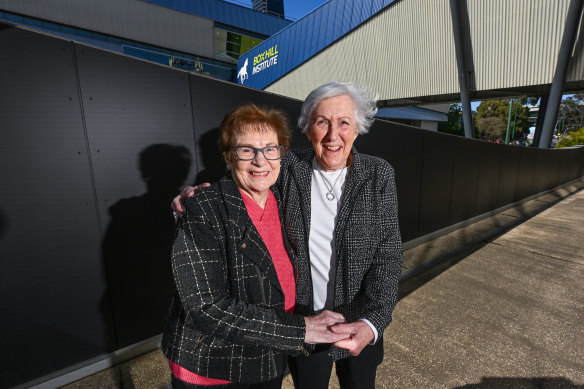
Joan Sweet (left) and Cate McMahon taught together at Box Hill Technical School for Girls and Women in the 1950s. Credit: Joe Armao
But her strong performance in class caught the attention of her teachers, who recommended she pursue the profession. Sweet returned after graduating as a student teacher, where she met long-time friend Cate McMahon.
McMahon had just stepped off a boat from England a month prior.
“Joan was at Box Hill then and she greeted me, and she was probably my main helper on how to operate the system,” says McMahon.
“I went to her wedding the next year. We just became friends. We used to visit each other, Christmas, Boxing Day, whatever. So we just became very close friends. In 2010, we … went to France together.”
Sweet remembers fondly her years teaching in Box Hill.
“They were very gentle times. Students had great respect for their teachers, by and large, and very seldom stepped out of line,” she says.
The Morning Edition newsletter is our guide to the day’s most important and interesting stories, analysis and insights. Sign up here.